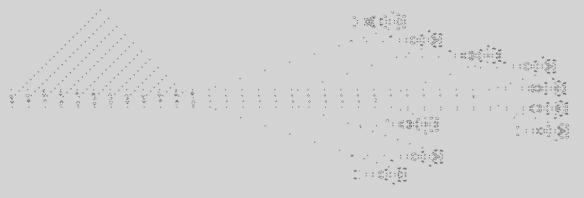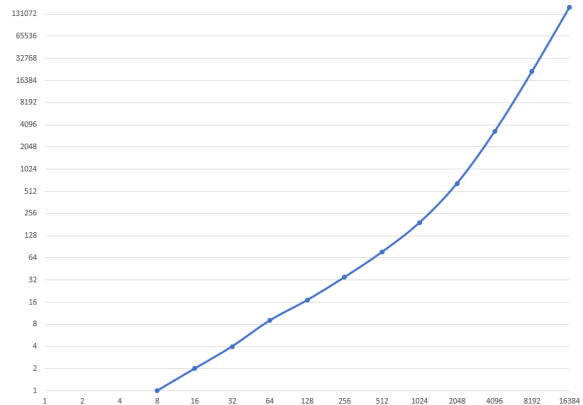Life, part 37
All right, let's finish this thing off and finally answer the question that I've been asking for a while: are there any Life patterns that have unbounded quadratic growth? (Code for this final episode is here.)
The answer is yes; there are several different kinds of patterns that exhibit quadratic growth. Today we'll look at one of them.
We know that guns, puffers and rakes all produce linear growth. But if we had a puffer whose debris was glider guns, that thing would have linear growth of glider guns, each of which has linear growth of gliders, and so that would be quadratic growth! Such a pattern is called a breeder".
ASIDE: Quadratic growth is the upper limit; do you see why? Making an argument for why no finite Life pattern can grow the total number of living cells more than quadratically is left as an exercise for the reader.
Let's see if we can make this happen.
Back in episode 22 I posted a puffer/rake that produces loafs, blocks and two streams of gliders, and said it was a simplified version of backrake 3".
There is rather a lot we can do to modify this pattern to change the stuff left in its wake. For example, if we put another pair of spaceships slightly behind the rake, the little spark" that the spaceship makes interacts with the loaves-and-blocks debris trail but not the gliders. The resulting chaos has the effect of destroying every other block, and all the loaves:
If we put a second pair of spaceships even further behind, they clean up the remaining blocks. This is the pattern backrake 3":
What's more, if we leave out one of those trailing spaceships, that's fine. We end up destroying the blocks on just one side and the other block remains.
Rounding out our collection of modifications, we can also put a spaceship off to either side such that when a glider collides with it, the glider is destroyed but the spaceship lives:
Summing up: by modifying our original puffer/rake we can produce any combination of:
- Gliders above, below, or neither
- Blocks and loaves, pairs of blocks, single blocks, or nothing.
That's interesting, but how does it get us to a quadratic-growth pattern? Patience! We will get there.
The next thing to consider is: we've seen that we can turn blocks-and-loaves into no loaves and half as many blocks. And we've seen that we can go from gliders to no gliders on either side. Could we make the glider stream half as dense? For example, could we destroy every other glider? Yes, by combining two of our patterns into a larger one. We'll combine:
- Single block, single glider
- No still Lifes debris, single glider
There is a way to cause a glider to hit a block such that both of them are destroyed, but the single blocks left behind by the puffer are spaced such that every other glider survives! Here the upper puffer is producing its usual spaceships and blocks, but the lower puffer has half of its gliders destroyed:
OK, so we can thin out a stream of gliders; that is another tool in our toolbox.
The next thing to know is that it is possible to create a huge number of interesting Life patterns by running gliders into each other; in fact, finding the glider synthesis" of a pattern is a major area of focus for Life enthusiasts. For example, if you collide two gliders together like this:
Then six generations later, there will be a pond" still Life:
If you then hit that pond with a second glider like this:
 Then four generations later it becomes a ship still Life:
Then four generations later it becomes a ship still Life:
So we can create ponds with two gliders and ships with three. If we then hit that ship with a glider like this:
Then it turns into the unstable queen bee" pattern:
But we know from episode 17 that two queen bees stabilized by two blocks makes a glider gun! We have rakes that produce streams of gliders, we have puffers that produce streams of blocks; put it all together and we get:
Breeder 1! Click on the image for a larger picture, load it into the executable for this episode, or take a look at it running on the wiki; it is quite hypnotic to watch all its intricate parts work together. With this pattern we add a new glider gun every 64 ticks, and then each glider gun produces a new glider every 30 ticks. It is obvious just from looking at the triangle of gliders that the population of gliders is growing as the square; it is making half a square.
It should come as no surprise that this pattern was created by Bill Gosper in the 1970s; just as he was the first to build a glider gun, so too was he the first to build a breeder.
What is the performance of our implementation of Hensel's QuickLife compared to Gosper's HashLife? Let's start by thinking about what we should expect with QuickLife. The time cost of one tick in QuickLife is proportional to the number of active Quad3s, and therefore the cost of computing tick number n should be proportional to n2. That means the total cost of computing ticks one through n should be proportional to n3.
I ran a similar test to the performance test from episode 35: I ran 8 generations, then restarted the engine and ran 16 generations, then restarted and ran 32 generations, and so on, up to 214 generations. This log-log scale chart is ticks on the x axis, milliseconds on the y axis:
Fascinating! We see that in the early part of the growth, we are basically linear; doubling the number of ticks doubles the amount of time it takes to compute. But by the time we are up to computing the first 8192 ticks or more, the total time is now growing as the cube, as we would expect. (Remember, the slope of the line on the log-log graph indicates the exponent of the geometric growth.)
What about Gosper's HashLife algorithm? Same test: start from the original breeder pattern, step forward some number of ticks. Of course we reset the caches after every test so as to fairly assign work done by a test to that test.
The astonishing result: 76 milliseconds, no matter how many generations we are stepping ahead! Notice that I'm not saying 76 milliseconds per generation; 76 milliseconds, period. Want to see what the pattern does after 214 generations? QuickLife took almost three minutes to compute that; HashLife does it in 76 milliseconds. 224 generations? 234? Same cost! It looks like magic.
What is happening here is of course Gosper's algorithm is exploiting the extraordinary amount of similarity in both space and time. The spaceship part of the breeder moves itself 32 cells and repeats its internal configuration every 64 ticks which is perfect for HashLife's quad-based memoizing. The glider guns are all the same, and the half-square of gliders is easily deduplicated no matter how big it gets.
Let's wrap it up here; I hope you enjoyed that exploration of Life algorithms as much as I did; I have been wanting to write this series for over a decade.
There is enormously more to Life; I feel like I have just scratched the surface in this series. There are many more patterns to explore and open problems to solve. And more generally there is active and interesting work being done by enthusiasts on cellular automata with different rules, different dimensions, different grid connectivity, and so on.
If you're interested in learning more, I highly recommend two things; first, the latest news in Life discoveries is available on the wiki that I have linked to many times in this series. Second, try playing around with Golly, a much more fully-featured and high-performance engine for exploring cellular automata than the little toy I've made for pedagogic purposes in this series. It implements both Gosper's HashLife and Hensel's QuickLife, along with variants for exploring other rule sets.
Coming up on FAIC: I'm going to take a short break from blogging for a bit; that last series was rather longer than I anticipated! We will probably then continue looking at Bean Machine, the probabilistic programming language I work on these days.










